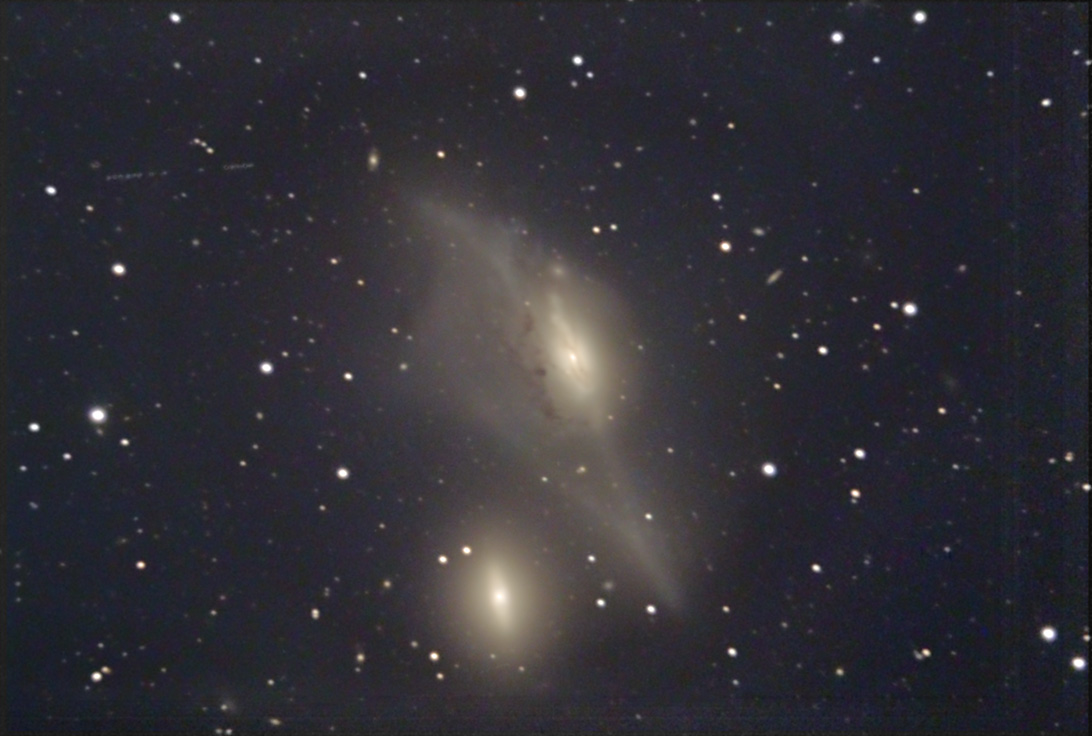NGC 4438 - The Eyes

For high resolution, click here.
NGC 4438 - The Eyes: This pair of interacting galaxies, called "The Eyes" is in the Virgo Cluster of galaxies near the boundary between the constellations Virgo and Coma Berenices. The larger galaxy is designated NGC 4438, and the smaller galaxy is designated NGC 4435. It appears that NGC 4438 has had some gravitational interactions in the past, but it has been suggested that M86 (a much more massive neighboring galaxy out of this field of view) is a more likely source of the disturbances than the smaller, lenticular galaxy NGC 4435 seen in the bottom of the frame. Besides the two bright ones, there are numerous other galaxies in the background of this image.
Besides the prominent galaxies (the intended target), perhaps the most interesting part of the image is the asteroid/minor planet crossing in the upper left part of the image. A more detailed analysis of the magnitude and trajectory are planned, but here is the "quick and dirty": for comparison, the bright star the object appears to be heading towards on the far left of the image has a catalog magnitude of 16.24, so the object is significantly dimmer than that. The object traveled approximately 300 pixels, or about 150 arc seconds, in the roughly 4 hours of images, which continuing at a constant rate would complete the orbit in about 4 years. That would put the object right in the middle of the asteroid belt between Mars and Jupiter. (You probably don't have to duck for this one.) A link to a short video showing the motion of this mystery object is included below.
NGC: 4438
Other Catalogs: Arp 120
Right Ascension: 12h 27m
Declination: 13° 0'
Apparent Magnitude: 10.0
Date: March 2014
Equipment:
Telescope: Meade 16" Schmidt Cassegrain with f6.3 reducer
Camera: SBIG ST-10XE
Guiding: Meade 5" refractor; Starshoot Autoguider; PHD
Exposure:
L: 14x10 minute subframes binned 1x1.
Color frames were taken with photometric (RVB), rather than photographic (RGB) filters.
R: 4x5 minute subframes binned 2x2.
V: 4x5 minute subframes binned 2x2.
B: 5x5 minute subframes binned 2x2.
Processing Notes: Data acquisition with CCDSoft. Reduction, and alignment with CCDStack. Subs combined in Sigma Combine. RVB combined in CCDStack with a ratio of 1:1.6:4. L and RVB images stretched and tweaked separately in Photoshop and combined with layers. Significant smoothing and increase in color saturation on RVB image and slight sharpening in the brighter areas of the L image.
Scale: .53"/pixel
Additional Comments: This was an "after data" image - the telescope was all set up and running after collecting data on various 2014 supernovae, so this target was selected to finish the night. RVB color was taken several nights later. Data were not processed until April 19, 2014.
The most interesting part of the image is the asteroid/minor planet crossing in the upper left part of the image. Typically, since a bright spot shows up in a different location for each subframe, the default processing should remove such "artifacts", thinking it could be a cosmic ray (or something) in an individual image. Since the combining parameters in Sigma Combine were not initially optimal, a noticeable trail showed up in the final image. Instead of trying to remove the artifact, I left it in as an interesting trail. After seeing this mystery object, I took all moderately acceptable subframes (23) and exported the "display" version from CCDStack as a set of cropped TIFF images that could be combined into a short video. That video is included below. The video shows all the challenges with having the telescope guide while you are asleep and unable to babysit the PHD guiding parameters. Lots of wobbles and guiding glitches, and an overall brightening of the image near the end of the sequence as the moon cam out and then dawn occurred. I had my DSLR camera set up outside the dome this night taking a time lapse seen on the "Moonrise" page found here:
http://www.fortlewis.edu/observatory/image_detail.asp?ID=280
A direct link to the youtube video of the mystery object is here:
http://youtu.be/vrcxm7MkeM8
or just click on the embedded version.
Views: 3016
 This work is licensed under a Creative Commons Attribution-NonCommercial-ShareAlike 4.0 International License.
This work is licensed under a Creative Commons Attribution-NonCommercial-ShareAlike 4.0 International License.

